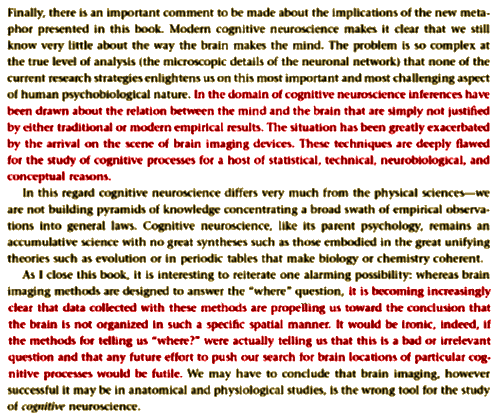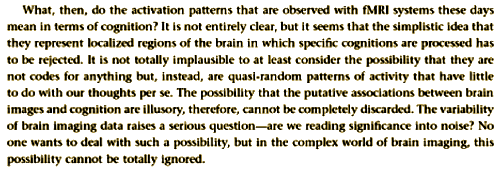The 1980 DSM-III Revolution made it to my life around 1984 with the coming of a new chairman to my department. All he talked about was research. It took me a while to figure out that meant drug research. But from the start, he also talked a lot about PET [Positron Emission Tomography], a technique that located injected labeled compounds in the brain when compared to a simultaneous CT scan. I’d never heard of such a thing at the time. But the ability to do these scans promised to bring breakthroughs in our understanding of the brain and mental diseases. Over the years, almost every presentation I attended reiterated the great hope of these scans. In the 1990s, we heard more about the Functional Magnetic Resonance Imaging [fMRI] that uses Blood-oxygen-level dependent [BOLD] contrast. No injection of radioisotopes required. The process uses the change in magnetization between oxygen-rich and oxygen-poor blood to highlight changes in oxygenation and blood flow – an index of neural activity. We’ve all seen the dramatic pictures – they’re everywhere.
The problem has been that thirty years have passed, and while neuroimaging is still in almost every forward thinking presentation, it hasn’t added much of anything to our understanding of cognition or mental disorders. That has been a huge disappointment to biologiical psychiatrists and neuroscientists. Usually, a technological advance like that opens whole new worlds in research, like for example the coming of the X-Ray machines. Like another scientific advance, the ability to read the genome, the practical advances just haven’t materialized. I’ve mentioned that the DSM-5 Task Force went out on a limb in planning to add biological markers to their Manual based on anticipated discoveries. They were forced to abandon that plan when these two new technologies failed to produce anything of note. The assumption has been that this failure is because the techniques are just not refined enough, or that the samples are too small. Maybe our clinical diagnostic categories are too crude, or too broad. So now there’s the The Research Domain Criteria project [RDoC] at the NIMH – looking for new ways of classifying psychopathology based on dimensions of observable behavior and neurobiological measures.
My own take on things is easily predicted. I think that there’s a widespread categorical error in psychiatric thinking that way over-estimates the contributions of biology and brain to mental illness. So I would say that they’re looking for biology in too many places. But I’m an amateur. Dr. William Uttal is something of an expert, and he can’t seem to write enough books putting forth his hypothesis that the neuroimaging efforts are based on an assumption that may well be flawed. Jamzo passed on a review of one of Uttal’s books:
by William R. Uttal
MIT Press, 2012
Review by Maura Pilotti, Ph.D.
Oct 15th 2013
While this particular book discusses the methodological problems in the neuroimaging studies and their applications to the cognitive sciences, it also gets at one of Dr. Uttal’s major criticisms of the basic assumptions in these studies. This quote is from the end of another of his books [p 378] –
Mind and Brain: A Critical Appraisal of Cognitive Neuroscience [2011]:
This is a criticism that explains the poverty of yield from the neuroimaging studies in a much more fundamental way. He is proposing that the cognitive processes of the Mind may not map onto the anatomy of the brain in either the brain structures or the neural circuits – that they don’t correlate with places in the brain at all:
So what are we to make of all the studies that report something like an enlarged amygdala? thinning or thickening of various anatomical structures? lighting up of various parts of the brain with differing stimuli? Are they just wishes of the investigators? I obviously don’t know the answers to those questions. But I’ll have to say that I’ve personally never read a neuroimaging study that I left feeling, "Boy, they really nailed that one!" It’s always fuzz to me. Dr. Uttal raises the possibility that that’s exactly what those findings really are – just some fuzz…


I’m not sure if I’m happy or sad for him.
Someday, somewhere in using future tests, maybe the rest of his field (and the other ‘neurosciences’) will wake up one day and rationalize… they don’t understand what neurology is doing. *what* is neurology doing?
Functional tests were built by engineers though applying neurology’s science (computational and molecular neuroscience).
A neurologist probably never thought a machine that uses positrons (anti-electrons) to make brain pictures would exist either, but they knew exactly what it was for.
Cognitive Neuroscience received the device differently (just poking fun)
http://images.tribe.net/tribe/upload/photo/e10/432/e1043254-e5f4-4613-bf3b-0d64e84268a7
Functional tests tell you if the organ measured is operating properly. Better, or worse. They have limits to what they can see at that too. That’s all it does…
The NIMH wants to build a better version of something that *literally already exists* (in three forms!) and can’t figure out how to even start. It’s because they don’t understand what it’s for, how could they ever build it.. 100 million tax payer dollars..
~fuzz
I really can’t even overemphasis.. at all!
Anyone who thinks they can look at machine’s extremely zoomed out pictures of a 100 billion parameter neural network and derive which parts are processing specifically what – by indications of whether or not it’s operating properly – Is looking at the @$#%ing monolith from 2001: A Space Odyssey.
The problem is that we all want finite answers in our life. 2 + 2 = 4, but what is four? That is when we get into trouble. Is 4 the number of people? Is 4 part of 6?
One of the many failures I perceive in medicine is looking for the finite. BP, BMI, A1c, and the list goes on and on as doctors try to medicate to a standard, a standard that is often flawed when looking at the person as a whole.
Drug companies have leveraged this need for decades into practice standards to sell product. Device and other medical equipment makers have driven the need to test and do to sell products.
Medicine needs to move away from the finite and back to a standard where the sick are cared for and the not so sick and healthy are allowed to live their lives.
Steve Lucas
” It’s always fuzz to me. Dr. Uttal raises the possibility that that’s exactly what those findings really are – just some fuzz…”
Your argument on a clinical level seem stronger than your argument on a more basic research level. To imply completely throwing out any regional specialization of brain function (perhaps I am misreading that you are allowing for that possibility) may be problematic.
Perhaps time for a guest post from someone who shares your basic concerns (eg dead salmon) but might provide a different lens?
Perhaps a guest post from Neuroskeptic?
Neuroskeptic?
By always looking for evidence to prove their hypothesis, biological psychiatrists are precluding discovery to the contrary. The result is an extraordinarily pricey snipe hunt.
The conviction that the mind is merely the machinery of a single brain is idiotic on its face. How so many people that consider themselves to be scientists can remain impervious to the biological fact that humans are social animals who develop architecture in our brains through association with other humans during a long childhood is perhaps a psychological mystery that these scientists need to work out among themselves with the help of therapy.
Biological psychiatry is not alone in its academic tendencies to disregard our helpless origins and the necessity of primary and secondary caregivers to our survival, but to do so while looking for explanations of the mind writ large is to deny ourselves.
Wiley,
You hit the nail on the head, neural networks learn. Who knows what they’re doing, our emotions may be hard wired for evolutionary purposes, but their only wired into what we learned. 🙂
I have nothing against psychotherapy, never did. It’s never hurt anyone like drugs have. Funny part it, regardless of the cause of illness, it’s better then nothing, and it works.
I’m not sure that anyone wants to completely discard the notion of regional specialization of brain function, but the smart money has always known that cognitive functioning isn’t so localized. It always amuses me when my colleagues talk about neuroplasticity as if it is a 21st century idea, when I clearly remember my mother and *her* colleagues (a learning disabilities pioneer and speech pathologist) talking about in the ’60s.
Plasticity implies that the function of structures is surprisingly fungible. My mom died in ’09 from Parkinson’s and (likely) Lewy Body, but I have always had the intuition– and it’s nothing more than that– that she was consciously attempting to shift speech, movement and memory to any damn neuron that wasn’t completely fried. One hell of a fight; I wonder if she bought herself another six months or a year, but of course, that’s impossible to know.
Catalyzt ,
a number of people have posted concern about regional specialization,
http://www.ninds.nih.gov/disorders/brain_basics/know_your_brain.htm
Specialization is incredibly generalized and every part is wired to the other part in order to complete any particular ‘higher’ function. We can’t really tell what any part is doing even f we destroy it to see what happens, because it’s plugged into everything else.
People with head injuries make amazing recoveries, so things can’t be all that precisely specialized in there. Neural networks learn, they don’t start with significant specialization – that’s something that by principle can only be learned. It’s amazing what people can do!
People with head injuries *can* make amazing recoveries. sorry, dropped a word there. There’s limits, and some structures are critical for certain things, like vision and such.